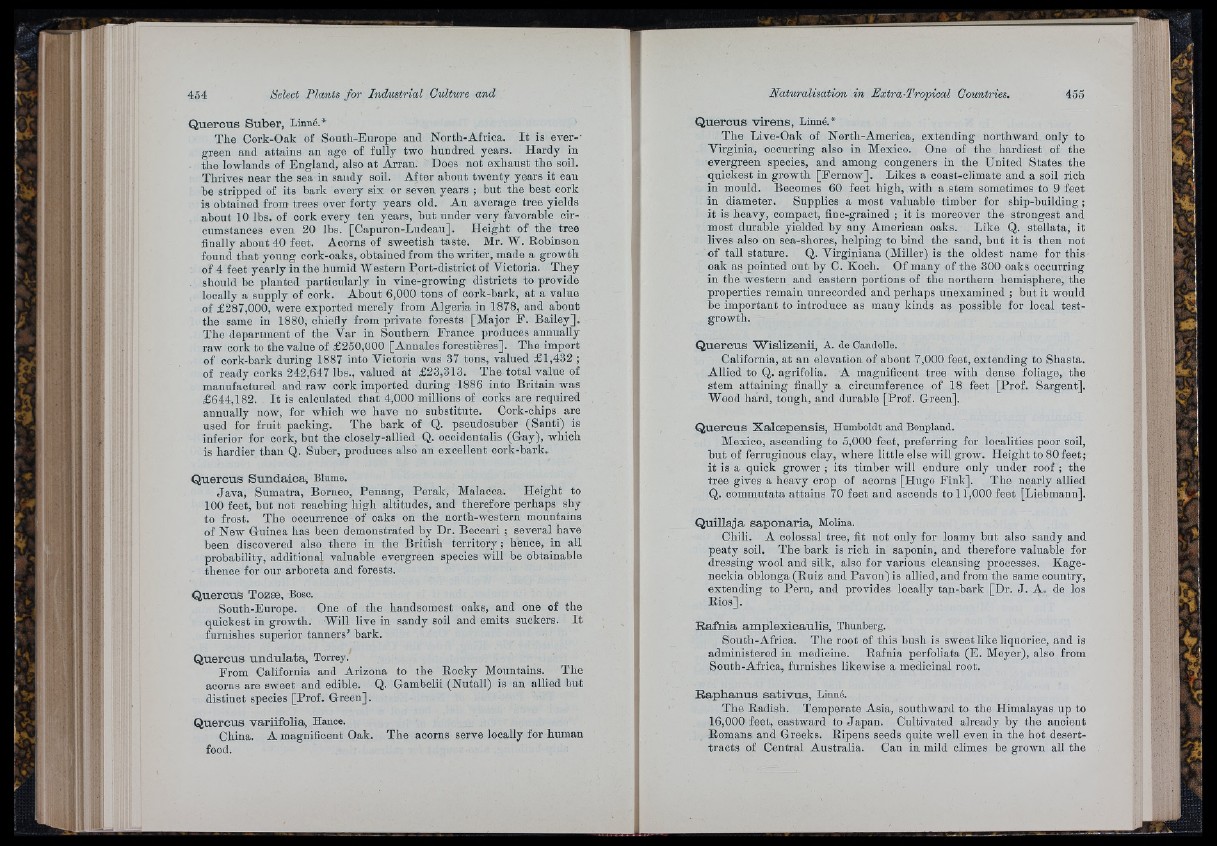
Q u e r c u s S u b e r , Linné.*
The Cork-Oak of South-Europe and North-Africa. I t is ever-'
green and attains an age of fully two hundred years. Hardy in
ithe lowlands of England, also a t Arran. Does not exhaust the soil.
Thrives near the sea in sandy soil. After abont twenty years it can
be stripped of its bark every six or seven years ; but the best cork
is obtained from trees over forty years old. An average tree yields
about 10 lbs. of cork every ten years, but under very favorable circumstances
even 20 lbs. [Capuron-Ludeau]. Height of the tree
finally about 40 feet. Acorns of sweetish taste. Mr. W. Robinson
found th a t young cork-oaks, obtained from the w riter, made a growth
of 4 feet yearly in the humid Western Port-district of Victoria. They
should be planted particularly in vine-growing districts to provide
locally a supply of cork. About 6,000 tons of cork-bark, a t a value
of £287,000, were exported merely from Algeria in 1878, and about
the same in 1880, chiefly from private forests [Major F . Bailey].
The department of the Var in Soutliern France produces annually
raw cork to the value of £250,000 [Annales forestières]. The import
of cork-bark during 1887 into Victoria was 37 tons, valued £1,482 ;
of ready corks 242,647 lbs., valued at £23,813. The total value of
manufactured and raw cork imported during 1886 into Britain was
£644,182. I t is calculated that 4,000 millions of corks are required
annually now, for which we have no substitute. Cork-chips are
used for fruit packing. The bark of Q. pseudosuber (Santi) is
inferior for cork, but the closely-allied Q. occidentalis (Gay), which
is hardier than Q. Suber, produces also an excellent cork-bark.
Q u e r c u s S u n d a io a , Blume.
Jav a, Sumatra, Borneo, Penang, Perak, Malacca. Height to
100 feet, but not reaching high altitudes, and therefore perhaps shy
to frost. The occurrence of oaks on the north-western mountains
of New Guinea has been demonstrated by Dr. Becoari ; several have
been discovered also there in the British territory ; hence, in all
probability, additional valuable evergreen species will be obtainable
thence for our arboreta and forests.
Q u e r c u s Tozae, Bose.
South-Europe. One of the handsomest oaks, and one of fhe
quickest in growth. Will live in sandy soil and emits suckers. I t
furnishes superior tanners’ bark.
Q u e r c u s u n d u l a t a , Torrey.
From California and Arizona to the Rocky Mountains. The
acorns are sweet and edible. Q. Gambelii (Nutall) is an allied but
distinct species [Prof. Green].
Q u e r c u s v a r iifo lia , Hance.
China. A magnificent Oak.
food.
The acorns serve locally for human
Q u e r c u s v i r e n s , Linné.*
The Live-Oak of North-America, extending northward only to
Virginia, occurring also in Mexico. One of the hardiest of the
evergreen species, and among congeners in the United States the
quickest in growth [Fernow]. Likes a coast-climate and a soil rich
in mould. Becomes 60 feet high, with a stem sometimes to 9 feet
in diameter. Supplies a most valuable timber for ship-building ;
it is heavy, compact, fine-grained ; it is moreover the strongest and
most durable yielded by any American oaks. Like Q. stellata, it
lives also on sea-shores, helping to hind the sand, but it is then not
o f tall stature. Q. Virginiana (Miller) is the oldest name for this
oak as pointed out by C. Koch. Of many of the 300 oaks occurring
in the western and eastern portions of the northern hemisphere, the
properties remain unrecorded and perhaps unexamined ; but it would
be important to introduce as many kinds as possible for local test-
growth.
Q u e r c u s W is liz e n ii, A. de Candolle.
California, at an elevation of about 7,000 feet, extending to Shasta.
Allied to Q. agrifolia. A magnificent tree with dense foliage, the
stem attaining finally a, circumference of 18 feet [Prof. Sargent].
Wood hard, tough, and durable [Prof. Green].
Q u e r c u s X a loe p e n s i s , Humboldt and Bonpland.
Mexico, ascending to 6,000 feet, preferring for localities poor soil,
bu t of ferruginous clay, where little else will grow. Height to 80 feet;
it is a quick grower ; its timber will endure only under roof ; the
tree gives a heavy crop of acorns [Hugo Fink], The nearly allied
Q. commutata attains 70 feet and ascends to 11,000 feet [Liebmann].
Q u i l la j a s a p o n a r i a , Molina.
Chili. A colossal tree, fit not only for loamy but also sandy and
peaty soil. The bark is rich in saponin, and therefore valuable for
dressing wool aud silk, also for various cleansing processes. Kage-
neckia oblonga (Ruiz and Pavon) is allied, and from the same country,
extending to Peru, and provides locally tan-bark [Dr. J . A. de los
R io s].
R a f n i a am p l e x ic a u l i s , Thunberg.
South-Africa. The root of this hush is sweet like liquorice, and is
administered in medicine. Rafnia perfoliata (E. Meyer), also from
South-Africa, furnishes likewise a medioinal root.
R a p h a n u s s a t iv u s , Linné.
The Radish. Temperate Asia, southward to the Himalayas up to
16,000 feet, eastward to Japan. Cultivated already by the ancient
Romans and Greeks. Ripens seeds quite well even in the hot desert-
tra c ts of Central Australia. Can in mild climes be grown all the